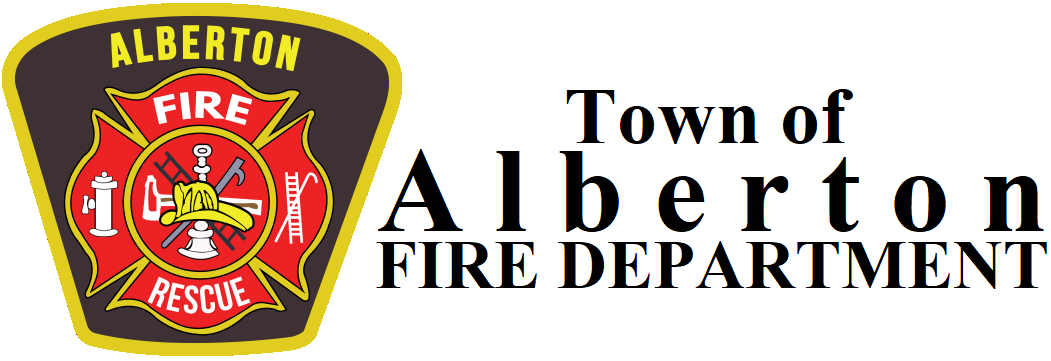|
About Us
Associations
History
Current Fleet
Decommissioned Vehicles
Past and Present Firefighter Equipment
Past Fire Chiefs
Uniforms and Shoulder Flashes
|
|
Past and Present Firefighter Equipment
Protective equipment for firefighters has drastically improved in recent years. This section provides a glimse at the equipment that was used by Alberton firefighters over the years and shows how firefighter equipment went from the most basic of items to the most sophisticated of systems.
|
The Early Years
From the time the Department was officially established in 1876 until about the 1940's, firefighter equipment, if it did exist, was rather sparse. During the Second World War, the fire hall served as the local headquarters for Air Raid Precaution (A.R.P.) control. When the war ended in 1945, the Town purchased equipment owned by the Civil Defense Committee. Numerous pieces of firefighting equipment including a pump, hoses, nozzles, sirens, and several articles for the firemen were acquired. These articles included rubber boots, coats, and overalls and though they were the most basic of items, they were definitely a welcome addition to the Department's limited inventory. In 1947, Town Council would approve the acquisition of another fire truck and at the same time, additional pairs of boots, coveralls, sou'westers, and six more rubber coats were also purchased.
|
|
The 1950's to 1970's
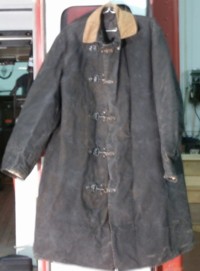
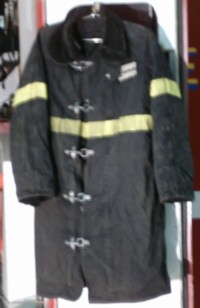 As time progressed into the 1950's, more formal firefighter equipment was obtained by the Department. Long black coats, like the one pictured far left, were acquired some time during the 1950's. Worn with these coats were tall rubber boots. This style of boot folded downwards towards the foot when not in use and were very similar in style to hip waders. The department would continue to use this type of boot for several decades until they were replaced by shorter boots with the advent of two piece bunker suits. During a transition period some pairs of the tall boots were modified for use with the modern firefighter equipment.
As time progressed into the 1950's, more formal firefighter equipment was obtained by the Department. Long black coats, like the one pictured far left, were acquired some time during the 1950's. Worn with these coats were tall rubber boots. This style of boot folded downwards towards the foot when not in use and were very similar in style to hip waders. The department would continue to use this type of boot for several decades until they were replaced by shorter boots with the advent of two piece bunker suits. During a transition period some pairs of the tall boots were modified for use with the modern firefighter equipment.
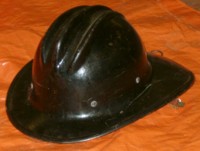
The 1950's also brought helmets to replace the sou'westers which offered no protection against falling debris. The black helmet, pictured right, is made from fibreglass and dates back to 1958. Though these helmets would provide better protection from falling debris, when members were summoned to incidents on the coldest of nights, this type of helmet provided little, if any, warmth as it did not have the liner like modern helmets do.
This style of equipment would be used through the 1960's and until the late 1970's when several safety modifications were made to the equipment used by firefighters. The coats, while remaining similar in appearance, were now made thicker to provide better protection against heat and flames and also included a reflective stripe which stretched across the chest, back, and upper arms. These coats also featured buckles which were stronger than those on the old type of coat.
|
|
The 1980's to 1990's
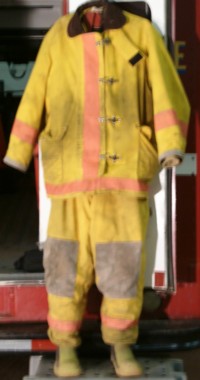
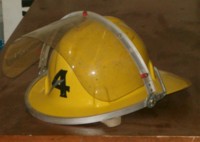
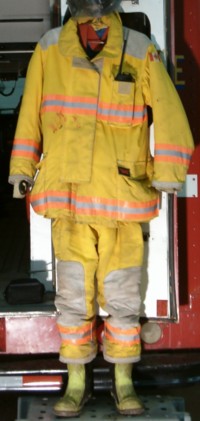
The 1980's brought many changes to equipment. Helmets, though changing slightly in appearance, remained essentially the same in style. However, there was one major change, that being the introduction of a protective face shield. This was an aftermarket item and it is believed these shields were acquired around 1983. An example of this type of shield is featured on the yellow helmet pictured left. The shield was attached to the helmet by a spring stretching across the back of the crown and a lip securing the helmet to the front brim. While the above mentioned style of helmet would remain in use over the next few years, the long coats and high boots would be phased out. Beginning in 1988, these would be replaced by shorter boots and a two piece suit, pictured left, which offered better protection and mobility for firefighters. These suits had additional reflective striping and were now bright yellow to provide higher visibility for firefighters. Also, as time progressed, a more modern looking helmet was brought in which featured a face shield which was bolted to the sides. This is essentially the same type of helmet which is used today.
A few years later these suits would be replaced. Beginning in 1996, suits which featured several convenience options for firefighters were bought and gradually replaced the old suits. These features included a pocket for a portable radio located over the left breast, larger coat pockets, and cargo pockets on the trousers. These suits also had new safety features including a flap over the coat's buckles, better reflective striping, and a higher and more enclosed collar. The coats also had extensions at the end of the sleeve which the thumb hooked into and prevented the sleeve from being accidently pushed up thereby exposing the arm. In the years that followed, additional suits of this type gradually replaced the older suits.
|
|
2000 to Present
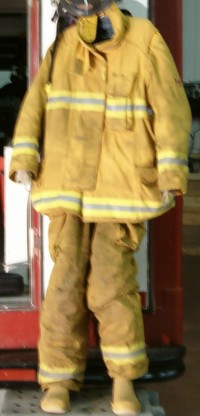
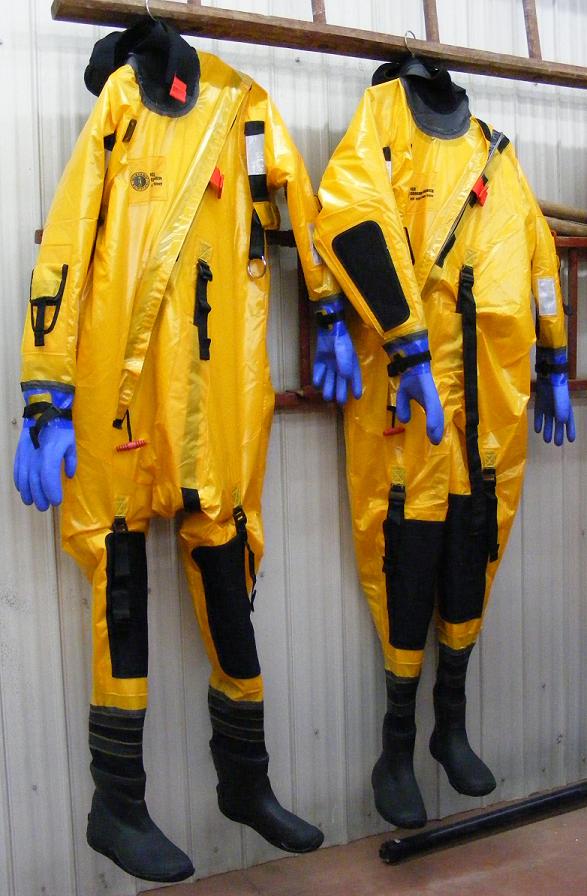
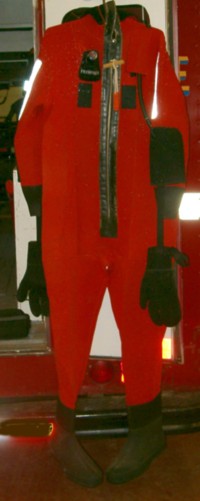
In late 2003, new gear would be acquired for a few members which had older suits. These suits are very similar to the previously mentioned type, except, as you can see, the orange reflective striping was replaced with yellow. This slight variation would not be copied for suits that were acquired only a few years after this as the Department would revert to the pattern of suit first introduced in 1996.
Just as the equipment for the job changed, so did the job. The expanding role and complexity of the operations a fire department carries out has steadily increased. During 2004-2005, water rescue equipment was acquired for the Department which included cold water suits. These suits allow firefighters to be immersed in cold water during a water rescue. The suit has attached boots and a hood and gloves tightly sealed at the cuffs. All of these features prevent water from entering inside the suit when the wearer is immersed. A new version of this suit would be acquired in 2013 which was a brighter colour (yellow) and had additional features to ensure no water enters the suit. A particular feature to note is that the boots and gloves are secured to the suit itself to ensure a watertight seal.
Beginning in 2010 new turnout suits would be acquired for the membership which featured further safety enhancements such as reinforced knee protection. This style of turnout gear marked a switch to yellow reflective stripes as well as a change in the base colour of the coat and pants to tan. Several personal and departmental identifiers were featured including the Department shoulder flash on the right sleeve and the words "Alberton Fire" on the back of the coat. The individual's name was also printed on a the bottom panel of the coat. All members currently have this style of suit.
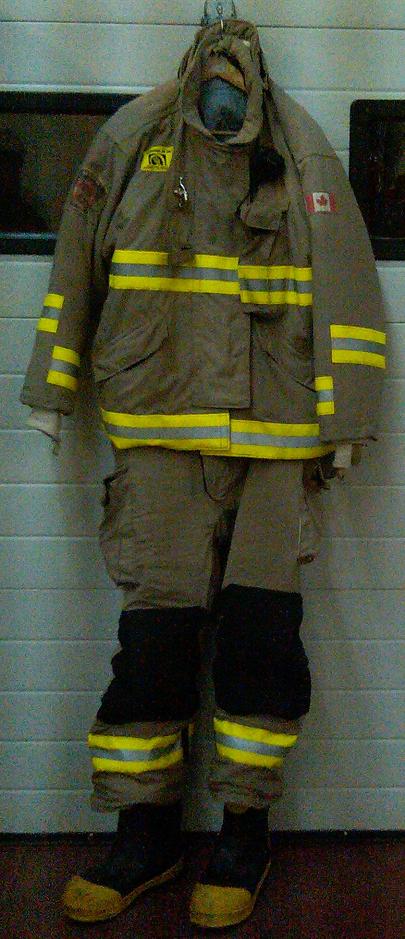
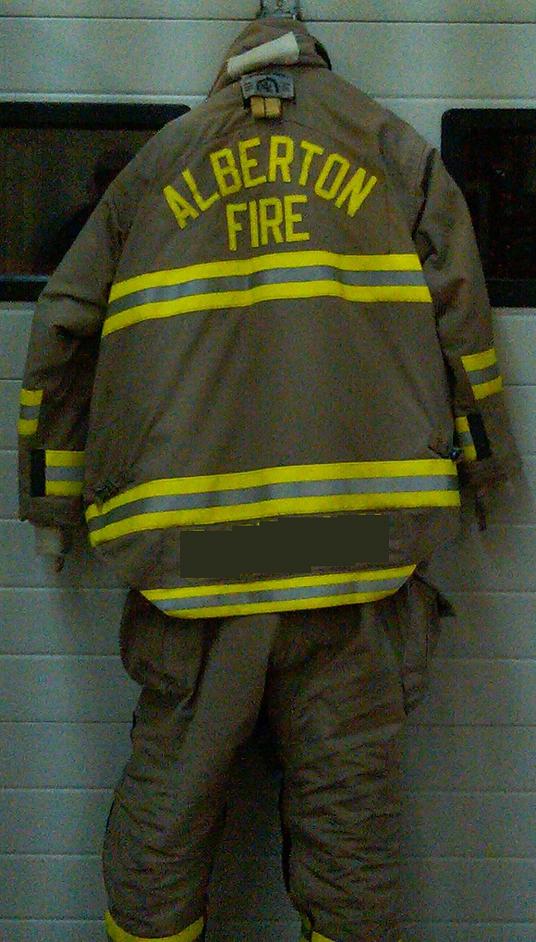
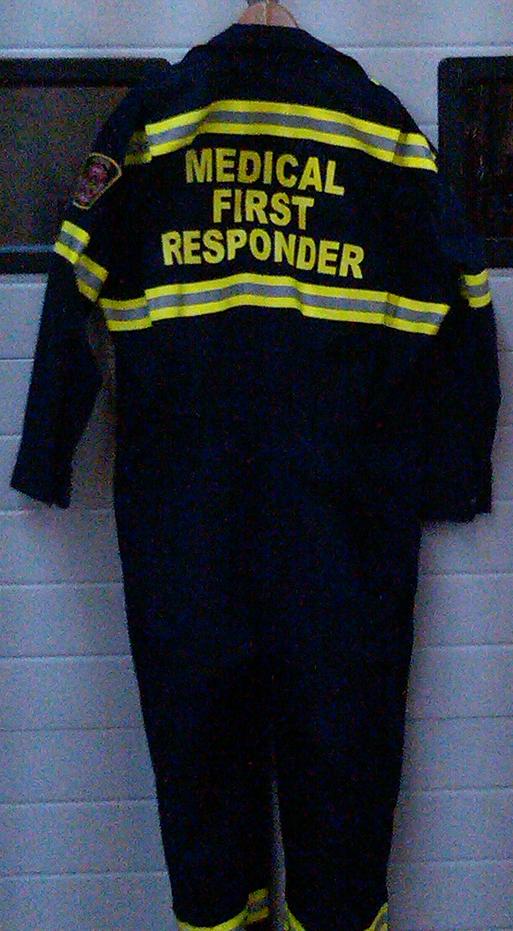 Around this time coveralls were also acquired for those firefighters that were trained as medical first responders. In recent years medical calls have become one of the most frequent type of call to which members are summoned. The coveralls serve as a means to protect and identify the member when responding to these calls and provide a lighter garment to wear in such circumstances when wearing regular turnout gear would be cumbersome. The coveralls feature yellow reflective stripes and the words "Medical First Responder" written on the back. Recent additions to the Department's inventory also include a lighter helmet which can be worn when firefighters are conducting confined space or high-angle rescues. This particular helmet was acquired in 2013.
Around this time coveralls were also acquired for those firefighters that were trained as medical first responders. In recent years medical calls have become one of the most frequent type of call to which members are summoned. The coveralls serve as a means to protect and identify the member when responding to these calls and provide a lighter garment to wear in such circumstances when wearing regular turnout gear would be cumbersome. The coveralls feature yellow reflective stripes and the words "Medical First Responder" written on the back. Recent additions to the Department's inventory also include a lighter helmet which can be worn when firefighters are conducting confined space or high-angle rescues. This particular helmet was acquired in 2013. 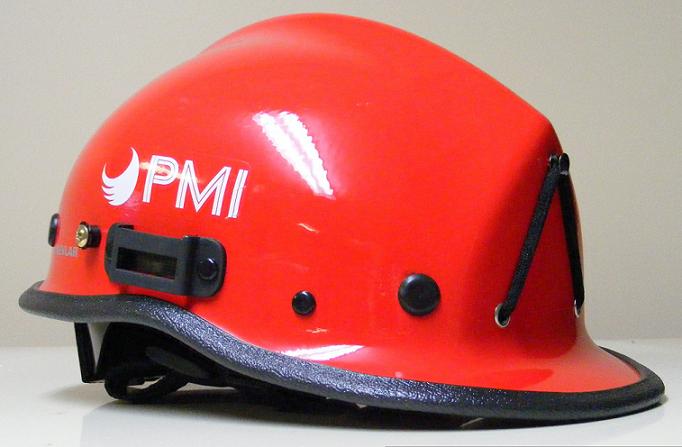
As you can see the equipment used by firefighters in general, let alone our department, has drastically changed over the years. Our inventory has gone from from the most basic of items to the most modern of equipment that is available today for conducting conventional fire suppression operations or handling complex rescue situations.
|
|
